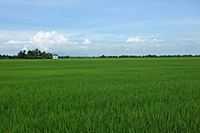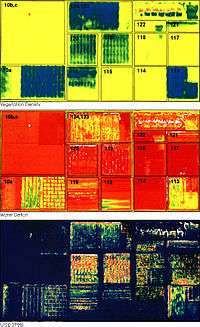Agriculture

Agriculture is the science, art, or practice of farming, including cultivation of the soil for the growing of crops and the rearing of animals to provide food, wool, and other products.
At right are farm buildings with trees surrounded by fields on a fair weather day.
Farming

"These three false-color images [on the right] demonstrate some of the applications of remote sensing in precision farming. The goal of precision farming is to improve farmers’ profits and harvest yields while reducing the negative impacts of farming on the environment that come from over-application of chemicals. The images were acquired by the Daedalus sensor aboard a NASA aircraft flying over the Maricopa Agricultural Center in Arizona."[1]
"The top image shows the color variations determined by crop density (also referred to as #147;Normalized Difference Vegetation Index”, or NDVI), where dark blues and greens indicate lush vegetation and reds show areas of bare soil."[1]
"The middle image is a map of water deficit, derived from the Daedalus’ reflectance and temperature measurements. Greens and blues indicate wet soil and reds are dry soil."[1]
"The bottom image shows where crops are under serious stress, as is particularly the case in Fields 120 and 119 (indicated by red and yellow pixels). These fields were due to be irrigated the following day."[1]
Theoretical agriculture
Def. the "art or science of cultivating the ground, including the harvesting of crops, and the rearing and management of livestock; tillage; husbandry; farming"[2] is called agriculture.
Agronomy

Def. "[t]he science of utilizing plants, animals and soils for food, fuel, feed, and fiber and more"[3] is called agronomy.
Forestry
Def. the science or practice of planting, managing, and caring for forests is called forestry.
"Continuous cover forestry (CCF) is not a new idea in forest management but there has been renewed interest in it for the potential it has to meet the sustainability requirements which are part of the Rio/Helsinki process and certification. Broadly speaking CCF includes those silvicultural systems which involve continuous and uninterrupted maintenance of forest cover and which avoid clearcutting."[4]
Horticulture
Def. the "art or science of cultivating gardens"[5] is called horticulture.
Gardening
Def. "the process or action of cultivating of the soil particularly in"[6] an "outdoor area containing one or more types of plants"[7] is called gardening.
Soils
"In soil, estimates are that 80 to 99% of the microorganisms remain unidentified (1)."[8]
"The soil at the Arlington site is a Plano silt-loam. The 20-cm-deep A horizon is a silt-loam and contains 4.4% organic matter. The loess mantel is >1.25 m deep. Four 2.5-cm-diameter soil cores were taken from the top 10 cm of a clover-grass pasture at the Arlington Agricultural Research Station. The soil samples were immediately placed on dry ice, mixed, and then stored at -70°C prior to DNA extraction. Soil analysis was done by the Soil Testing Laboratory of the University of Wisconsin—Madison as described by Schulte et al. (40). The soil sample contained 13% sand, 70% silt, 17% clay, 4.4% organic matter, 0.3% total N, 400 ppm of K+, and 98 ppm of P. The soil pH was 6.5. The site is well drained, with groundwater more than 25 m below the surface. Two-thirds of the 79-cm annual rainfall occurs from April to October. The site has an average of 165 frost-free days."[8]
Research
Hypothesis:
- A farm may be as small as an individual tract of land to as large as a country.
Control groups

The findings demonstrate a statistically systematic change from the status quo or the control group.
“In the design of experiments, treatments [or special properties or characteristics] are applied to [or observed in] experimental units in the treatment group(s).[9] In comparative experiments, members of the complementary group, the control group, receive either no treatment or a standard treatment.[10]"[11]
Proof of concept
Def. a “short and/or incomplete realization of a certain method or idea to demonstrate its feasibility"[12] is called a proof of concept.
Def. evidence that demonstrates that a concept is possible is called proof of concept.
The proof-of-concept structure consists of
- background,
- procedures,
- findings, and
- interpretation.[13]
See also
References
- 1 2 3 4 Susan Moran (30 January 2001). "Precision Farming". Washington, DC: NASA. Retrieved 2016-02-07.
- ↑ "agriculture, In: Wiktionary". San Francisco, California: Wikimedia Foundation, Inc. June 17, 2012. Retrieved 2012-08-07.
- ↑ "agronomy, In: Wiktionary". San Francisco, California: Wikimedia Foundation, Inc. February 11, 2012. Retrieved 2012-08-07.
- ↑ A. Pommerening and S.T. Murphy (2004). "A review of the history, definitions and methods of continuous cover forestry with special attention to afforestation and restocking". Forestry 77 (1): 27-44. doi:10.1093/forestry/77.1.27. http://forestry.oxfordjournals.org/content/77/1/27.full.pdf. Retrieved 2016-02-07.
- ↑ "horticulture, In: Wiktionary". San Francisco, California: Wikimedia Foundation, Inc. October 8, 2013. Retrieved 2013-10-25.
- ↑ "gardening, In: Wiktionary". San Francisco, California: Wikimedia Foundation, Inc. October 8, 2013. Retrieved 2013-10-25.
- ↑ "garden, In: Wiktionary". San Francisco, California: Wikimedia Foundation, Inc. October 15, 2013. Retrieved 2013-10-25.
- 1 2 James Borneman, Paul W. Skroch, Katherine M. O'Sullivan, James A. Palus, Norma G. Rumjanek, Jennifer L. Jansen, James Nienhuis, and Eric W. Triplett (June 1996). "Molecular Microbial Diversity of an Agricultural Soil in Wisconsin". Applied and Environmental Microbiology 62 (6): 1935-43. http://aem.asm.org/content/62/6/1935.short. Retrieved 2013-11-21.
- ↑ Klaus Hinkelmann, Oscar Kempthorne (2008). Design and Analysis of Experiments, Volume I: Introduction to Experimental Design (2nd ed.). Wiley. ISBN 978-0-471-72756-9. http://books.google.com/?id=T3wWj2kVYZgC&printsec=frontcover.
- ↑ R. A. Bailey (2008). Design of comparative experiments. Cambridge University Press. ISBN 978-0-521-68357-9. http://www.cambridge.org/uk/catalogue/catalogue.asp?isbn=9780521683579.
- ↑ "Treatment and control groups, In: Wikipedia". San Francisco, California: Wikimedia Foundation, Inc. May 18, 2012. Retrieved 2012-05-31.
- ↑ "proof of concept, In: Wiktionary". San Francisco, California: Wikimedia Foundation, Inc. November 10, 2012. Retrieved 2013-01-13.
- ↑ Ginger Lehrman and Ian B Hogue, Sarah Palmer, Cheryl Jennings, Celsa A Spina, Ann Wiegand, Alan L Landay, Robert W Coombs, Douglas D Richman, John W Mellors, John M Coffin, Ronald J Bosch, David M Margolis (August 13, 2005). "Depletion of latent HIV-1 infection in vivo: a proof-of-concept study". Lancet 366 (9485): 549-55. doi:10.1016/S0140-6736(05)67098-5. http://www.ncbi.nlm.nih.gov/pmc/articles/PMC1894952/. Retrieved 2012-05-09.
External links
- African Journals Online
- Bing Advanced search
- GenomeNet KEGG database
- Google Books
- Google scholar Advanced Scholar Search
- Home - Gene - NCBI
- JSTOR
- Lycos search
- NASA's National Space Science Data Center
- NCBI All Databases Search
- Office of Scientific & Technical Information
- PubChem Public Chemical Database
- Questia - The Online Library of Books and Journals
- SAGE journals online
- The SAO/NASA Astrophysics Data System
- Scirus for scientific information only advanced search
- SIMBAD Astronomical Database
- SIMBAD Web interface, Harvard alternate
- Spacecraft Query at NASA.
- SpringerLink
- Taylor & Francis Online
- WikiDoc The Living Textbook of Medicine
- Wiley Online Library Advanced Search
- Yahoo Advanced Web Search
- Google Map of Farms by Type
| |||||||||||||||||||||||||||||||||||||||||||||||||||||
| ||||||||||||||||||||||||||||||||||||||||||||||||||||||||||||||
| |||||||||||||||||||||||||||||||||||
| |||||||||||||||||||||||||||||||||||||||||
![]() This is a research project at http://en.wikiversity.org
This is a research project at http://en.wikiversity.org
| |
Educational level: this is a research resource. |
| |
Resource type: this resource is an article. |
| |
Resource type: this resource contains a lecture or lecture notes. |
| |
Subject classification: this is a biology resource . |
| |
Subject classification: this is a genetics resource. |
| |
Subject classification: this is a technology resource . |